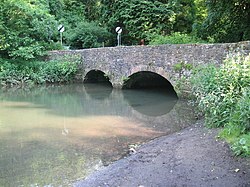Mells River
| Mells River | |
|---|---|
 Bridge over the Mells River at Great Elm | |
 | |
| Location | |
| Country | England |
| County | Somerset |
| Cities | Gurney Slade, Mells, Great Elm, Frome |
| Physical characteristics | |
| Source | |
| • location | Somerset, England |
| • elevation | 2 m (6 ft 7 in) |
| Mouth | River Frome |
• location | Frome, Somerset, England |
• coordinates | 51°14′50″N 2°19′14″W / 51.24722°N 2.32056°W |
| Basin features | |
| Tributaries | |
| • right | Finger Stream, Whatley Brook, Nunney Brook |
The Mells River flows through the eastern Mendip Hills in Somerset, England. It rises at Gurney Slade and flows east joining the River Frome at Frome.
The river forms one of the boundaries of Mells Park, a country house estate in Mells.[1] A few kilometres downstream it flows between the pre-Roman fortifications of Wadbury Camp to the north and Tedbury Camp to the south.[2] The river flows through the western part of the Harridge Woods nature reserve.[3]
Mells River also powered the Old Ironstone Works[4] and several other mills set up by James Fussell III in 1744.[5] It is now a 0.25 hectare biological Site of Special Scientific Interest, as it is used by both Greater and Lesser Horseshoe Bats.[6][7]
Vobster Inn Bridge, which carries the lane over the Mells River, is dated 1764, and is Grade II listed.[8] At Great Elm the Murtry Aqueduct,[9] built around 1795, carried the Dorset and Somerset Canal over the river.
The river takes the outfall from Whatley Quarry.[10] Downstream of the outfall is the Mells River Sink. This acts as a spring when the water table is high and as a sink into underground aquifers, through the Limestone, when the water table is low.[11] Water tracing showed this to be part of an underground part of the river 2.5 kilometres (1.6 mi) long. Archaeological investigations found the remains of woolly rhinoceros bones and a 1st-century bronze brooch.[12]
References
- ^ "Park, Mells". Somerset Historic Environment Record. Somerset County Council. Retrieved 2009-09-25.
- ^ Phelps, William (1836), The History and Antiquities of Somersetshire: Being a General and Parochial Survey of that Interesting County. To which is Prefixed an Historical Introduction, with a Brief View of Ecclesiastical History; and an Account of the Druidical, Belgic-British, Roman, Saxon, Danish, and Norman Antiquities, Now Extant, J.B. Nichols and son, p. 105, retrieved 2016-08-19
- ^ Harridge Woods Leafet (PDF), Somerset Wildlife Trust, retrieved 2016-08-22
- ^ "The Case for Extending the Mendip Hills Area of Outstanding Natural Beauty". Mendip Hills Society. 2005. Retrieved 2010-10-16.
- ^ Atthill, Robin (1964). Old Mendip. Newton Abbott: David and Charles. ISBN 0-7153-5171-0.
- ^ "English Nature citation sheet" (PDF). 2006. Retrieved 2006-07-25.
- ^ Thornes, Robin (2010). Men of iron. The Fussells of Mells. Frome Society for Local Study. ISBN 978-0-9565869-1-9.
- ^ "Vobster Inn Bridge". historicengland.org.uk. Retrieved 2006-11-14.
- ^ "Murtry Aqueduct". historicengland.org.uk. English Heritage. Retrieved 2009-09-25.
- ^ "Quarry control helps maintain river levels". ABB. Retrieved 2009-09-25.
- ^ "Mells and the Wadbury Valley". British Geological Survey. Retrieved 2009-09-25.
- ^ Stanton, W.I. (1982). "Mells River Sink: A spelaeological curiosity in east mendip Somerset" (PDF). Proceedings of the University of Bristol Spelæological Society. 16 (2): 93–104.
